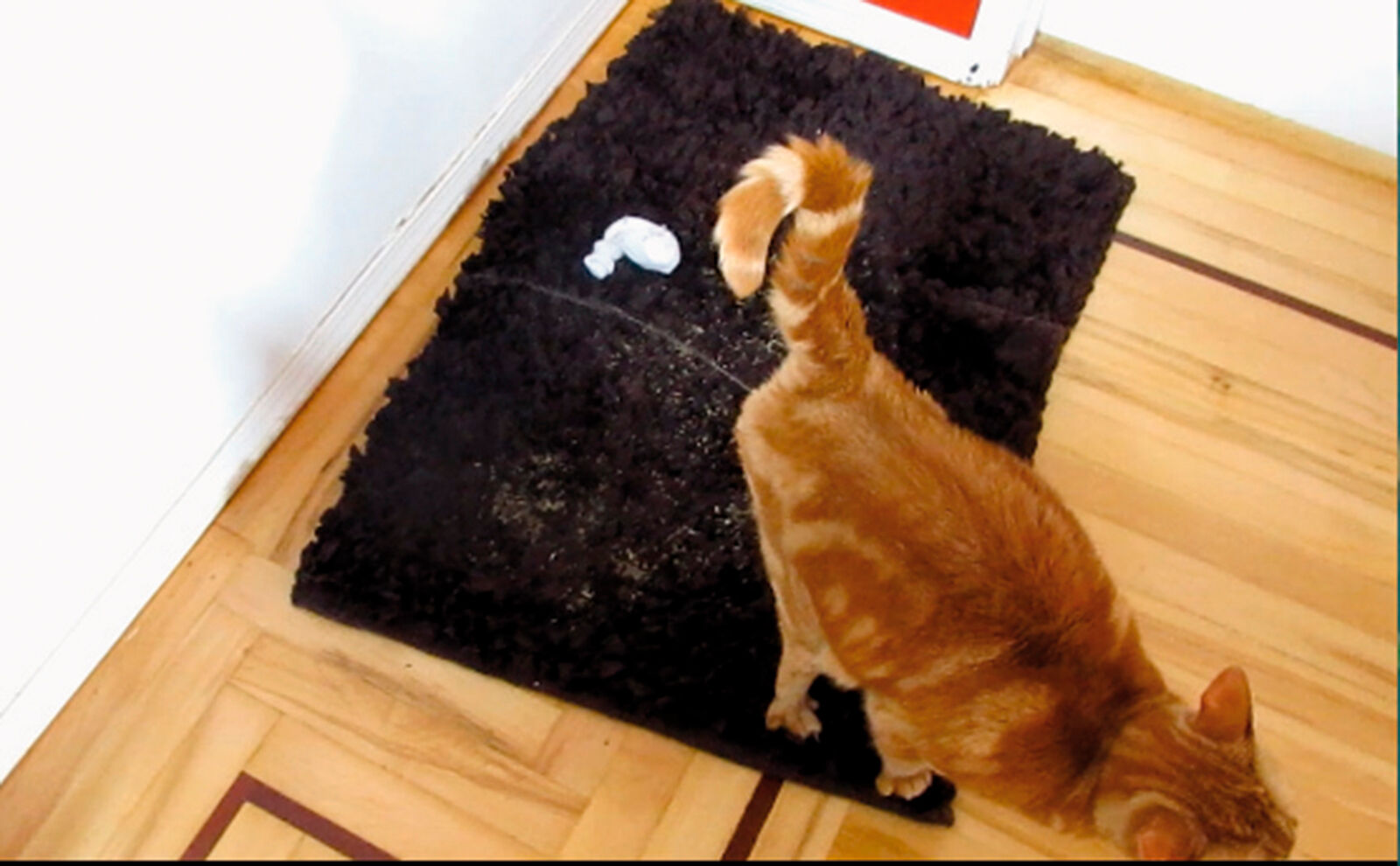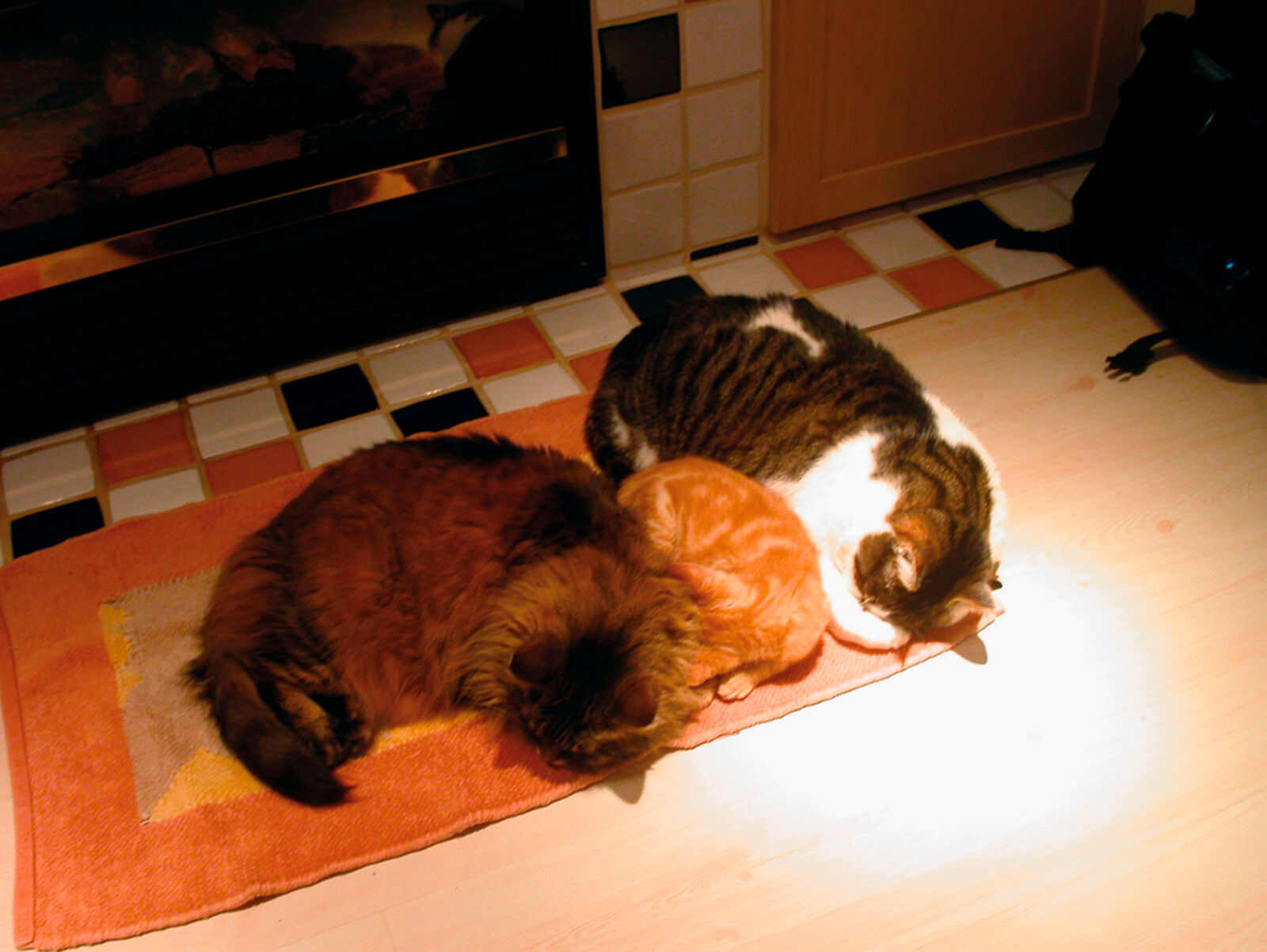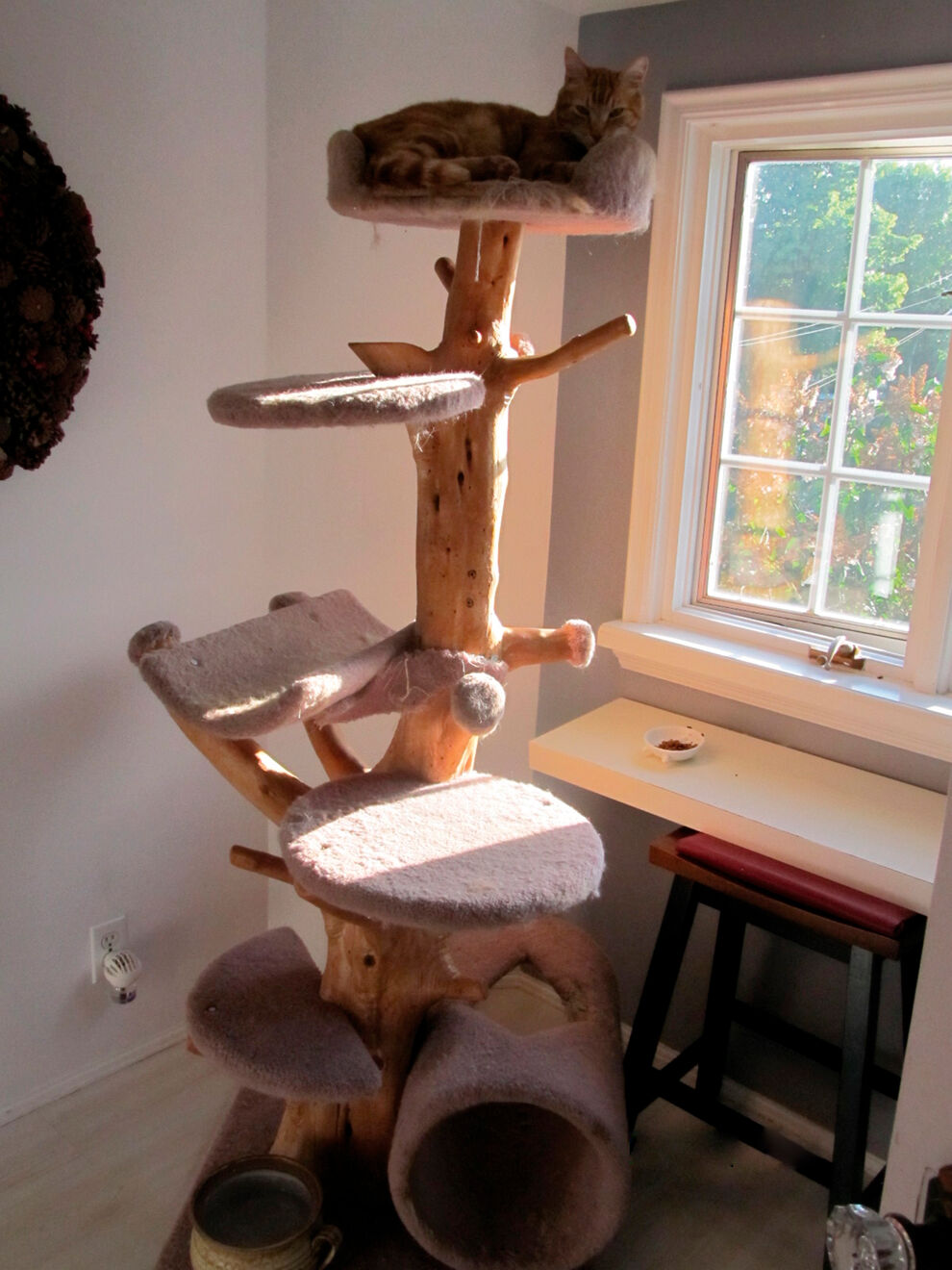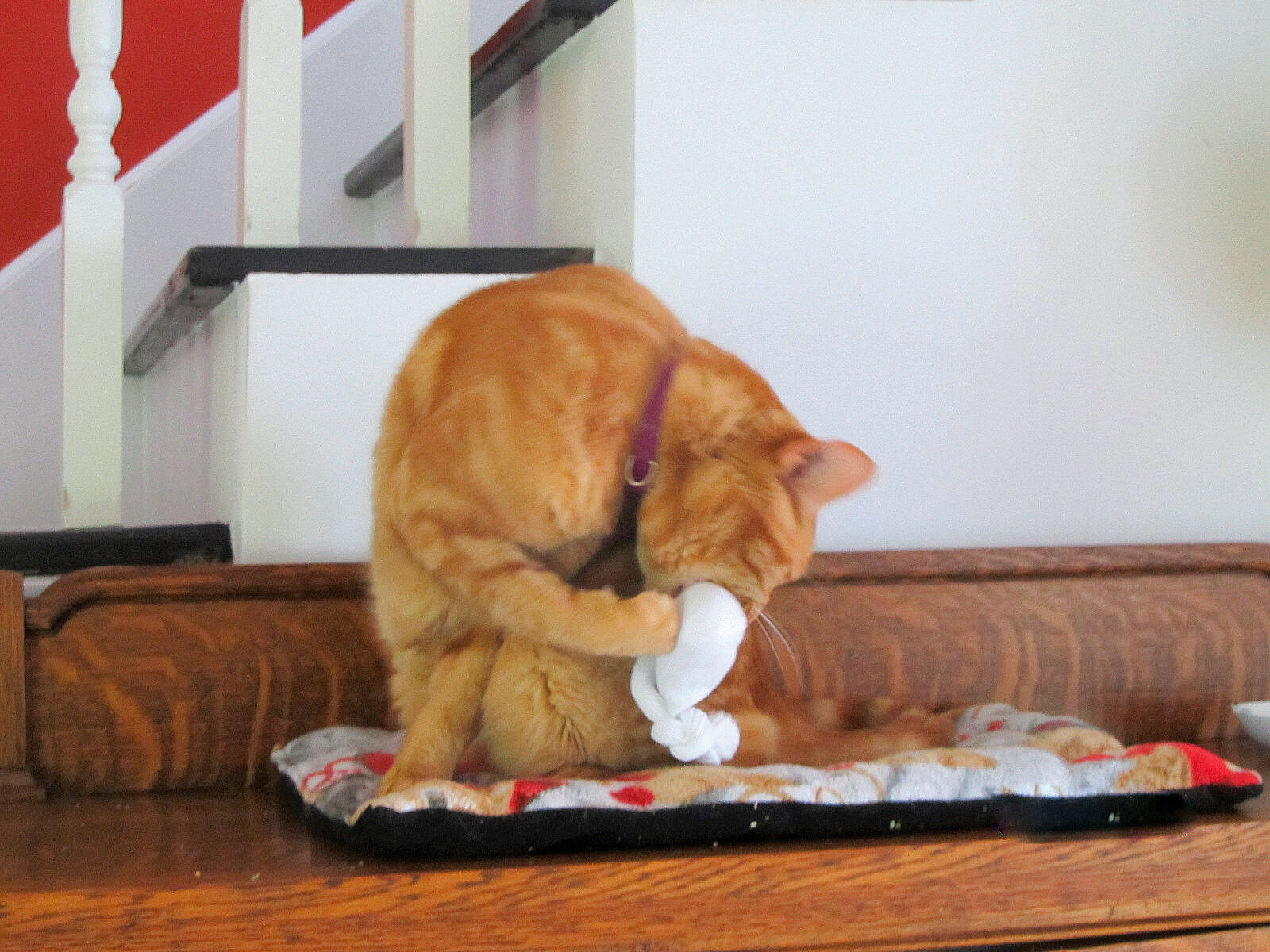Optimizing an indoor lifestyle for cats
People benefit from living with pets. As companions, they provide stress relief, stability of routine, and improved health. Yet how to best care for our cats remains controversial, and there are cultural and regional differences in what people believe is the best way to house cats.

Key Points
Offering outdoor access does not compensate if the cat has poor conditions indoors.
All environmental and social needs must be met for successful indoor living, and the well-being of each cat needs to be evaluated repeatedly over time.
Cats restricted to indoor living have a reduced risk for vehicular trauma, predation, aggressive interactions with cats and other animals, and exposure to infectious diseases.
Not all cats can adapt readily to an indoor lifestyle, and may be at increased risk for certain behavioral and medical problems.
Indoor living is not without risks.
Predictability, familiarity, routine and having a sense of control are key factors in reducing stress.
Introduction
As long ago as 1997, between 50-60% of cats were housed strictly indoors [1] in the United States [2], whereas in the United Kingdom the majority of cats were allowed outside [3], whilst a study from Melbourne, Australia reported that 23% of cats were “mainly indoors” [4]. Why are there such “cultural” differences? The decision to keep a cat indoors may be practical: living on the 21st floor of an apartment building in a busy city prevents ready access to the outside. In other situations, it is true that keeping a cat indoors reduces the risks from wandering, poisoning, automobile accidents, contagious disease or fights with other animals [5][6], and owners may also believe that it removes the risk of internal and external parasites (e.g., heartworm, fleas). Other reasons to keep cats indoors include avoidance of unwanted pregnancy (assuming the pet is not spayed) and to protect wildlife.
What are the effects of indoor living on cats?
Are there any downsides to keeping cats strictly indoors? There is a reality-perception mismatch if owners think that their indoor cat’s life is free from perils, as the indoor cat experiences different hazards. These include falls from balconies and windows, kitchen scalds or burns, and access to toxic cleaning products, unsuitable food (e.g., onion, garlic) and plants [3] (Table 1). Studies comparing mortality of cats housed indoors with those allowed outside are not available in the North American veterinary literature [7]. However, cats have not been selectively bred to be indoors 24 hours a day, and many do not adjust to living in close contact with people [4]. For this adaptation to be successful, a cat must have had complete and successful socialization to people prior to eight weeks of age [4]. Additionally, because fearful traits can be inherited, some cats will be unsuited to close human contact [4]. Similar concerns exist when trying to integrate cats from different sources: this requires early socialization and cats have different personalities (e.g., sociable, timid and unfriendly, active and aggressive) that may be incompatible [8].
| Increased risks associated with living strictly indoors | Increased risks associated with outdoor access |
|---|---|
|
|

A monotonous and overly predictable environment is stressful [9]. Cats may not be able to perform behaviors that express their natural telos – their cat-like nature. The resulting psychological and physiological stress may develop into either problem behaviors (natural behaviors that are unwelcome, e.g., spraying or scratching), behavior problems (e.g., obsessive grooming), or physical illness. Signs of stress and anxiety may be overt (e.g., changes in appetite, grooming, increased vocalization, hiding, vigilance, aggression, spraying or compulsive behaviors (Figure 1)), or subtle (e.g., decreased activity, play, exploratory behavior/inquisitiveness, facial marking, affiliative interactions with people and other animals) [10].
Certain physical illnesses are more prevalent in indoor cats (Table 1) although it can be argued that indoor cats may be more closely observed, so that behavior changes are more readily noticed, or they receive more frequent veterinary care, so that diseases are identified more readily than in free-roaming cats, but this is only conjecture. One source states that “the disparity between physical and psychological stressors is an illusion. Host defense mechanisms respond in adaptive and meaningful ways to both” [11].
What cats need to be cats
Reducing stress for cats requires an understanding of who and what a cat is and what they need. Cats are territorial, with their territories based around essential resources, most prominently food. Both males and females mark their territories with olfactory clues: spraying urine, rubbing against objects and scratching vertical surfaces (which provides both olfactory and visual signals). Resource areas may be time-shared, so cats circumvent confrontation by avoiding contact. Fighting is a last resort and occurs when escape is impossible. Cats require privacy for hiding, safety, observation, undisturbed rest, and sleep, whilst vantage positions allow cats to avoid or evade intruders, predators and other threats. Socially, cats may live on their own or in groups. Colonies consist of related females and their offspring, with males visiting for reproductive purposes, although they may help to provide care for related young until they are mature, either sexually or socially [12].
The ”Five Freedoms”, first described in 1965 to define farm animal welfare*, have more recently been adapted for cats, as follows [3]:
- Provision of food and water: a balanced diet that meets the animal’s nutritional needs at every life stage, and fresh water.
- Provision of a suitable environment: adequate space and shelter, with sufficient light, low noise levels and no extremes of temperature. The area can be indoor only or with outdoor access.
- Provision of healthcare: vaccination, neutering (sterilization), parasite control, individual identification (microchip, collar), and prompt access to veterinary care.
- Provision of opportunities to express most normal behaviors, including those directed towards conspecifics, and humans.
- Provision of protection from conditions likely to lead to fear and distress.
*The Brambell Report, December 1965 (HMSO London, ISBN 0 10850286 4)
While the vast majority of cats kept indoors will have adequate food and water, and illnesses addressed when noticed, many do not have the ability to express normal cat behaviors. This may result in distress, fear, undesirable behaviors, and potentially illness. Typical cat behaviors include play, investigation, observation, hunting, feeding, drinking, grooming, scratching, traveling, scent marking, eliminating, resting, and sleeping [13][14][15]. Additionally, cats are crepuscular, i.e., their peak activity times are around dusk and dawn.
Indoor life and obesity
Indoor confinement predisposes to obesity. There are numerous reasons for this, including the most obvious one, i.e., ingesting more calories than they are utilizing. However, it is more complicated than this. In nature, cats do not have ad libitum food intake. To avoid starvation, the drive to eye, stalk, pounce and kill is permanently active, and a cat makes numerous hunting attempts for every successful kill [16]. Mostly, prey are small mammals or birds, and a cat may hunt 100 times each day to meet its caloric requirements (10-20 small prey), an intellectually stimulating and physically active endeavor.Our cats receive food with minimal effort, becoming overweight because they eat too much, and their food is often calorie-dense. One mouse (=30 kcal) meal is approximately 10 pieces of an average maintenance dry food; even eating 10 extra pieces per day can result in a 10% weight gain over a year. Owners like to see their cats eat and may interpret inquisitive, verbal or rubbing cues from a cat as a request to be fed; rewarding such actions with food reinforces the cat’s behavior, and the owner feels needed and cared for. We inadvertently train cats to ask for food, and they train us to respond to their boredom or other unmet needs by feeding them.
Neutering (males and females) reduces energy requirements by between 7-33% (most studies indicate 20-25%). Additionally, feeding induces release of neurochemicals that make the cat feel good, and eating becomes a solace for negative experiences (distress, fear) or boredom. In a multi-cat household, if the cats are stressed due to incomplete socialization, they can express this by overeating, especially if they cannot achieve and maintain a comfortable spacing.
Obesity is a huge problem in cats. One study [17] determined that the risk factors associated with overweight or obesity were frequency of feeding and neutered status, regardless of whether cats were indoors or outdoors. Cats fed 2-3 times daily were more likely to be overfed than those offered ad libitum feeding. While contradicting the findings of other studies, this reinforces the importance of owner education regarding the amount and type of food to feed. Many diets developed for indoor cats have a higher proportion of calories derived from protein to help offset decreased exercise, and are fiber-enhanced to improve stool character, reduce fecal odor, and to help promote intestinal motility to reduce hairballs.
Optimizing the indoor environment
There are two aspects that need to be considered: the first is to decrease stressful stimuli, and the second is to improve and enrich the environment. They may overlap in some instances, e.g., boredom is not a direct threat in the way that confrontation with another pet might be, but it is still a source of stress.
Stress results from unpleasant, noxious stimuli that cannot be predicted or controlled [18]. These may be physical or social in nature. Early life experiences as well as genetics play a role in an individual’s ability to adapt to situations. A barren environment or a chaotic one with excessive novelty are both undesirable; e.g., a new member in the household, changes in routine or in the physical environment. Poor relationships with other animals and humans are stressful. Competition for resources may be real (with another animal or a teasing human) or perceived (inability to reach resources, fear of ambush). Most anxiety disorders (e.g., urine spraying) are a result of social or environmental stress [12]. The source of stress should be identified and removed whenever possible. Reducing disruption and creating a more predictable, harmonious schedule and environment is helpful. When the stimulus lives with the cat, (e.g., another cat, a person), a gradual and prolonged reintroduction protocol, paired with positive, pleasant reinforcement, will be needed in order to reshape the cat’s experience.
If a change in routine is unavoidable, proactive positive conditioning will be helpful – so, for example, to prepare for a veterinary visit, encourage the pet to regard the cat carrier in a positive manner, e.g., by putting food in the carrier and emphasizing its desirability and safety.
Environmental enrichment refers to both the physical and social environment and should include temporal complexity (i.e., variability) [15]. The goal is to offer more behavioral diversity, increase the use of space, enhance the human-cat relationship and – ultimately – improve an individual’s ability to cope with adversity, thus decreasing the expression of abnormal and undesirable behaviors [3].

Depending on resource availability, free-ranging cats occupy huge ranges, from 1.2-2450 acres (0.48-990 hectares). Clearly indoor apartments are too small for the average cat, and this situation is made worse by adding unrelated and/or unfamiliar cats [12]. An indoor environment should consist of at least two rooms, but cats also need complex, stimulating, three-dimensional space; allowing a cat to climb provides distance from other cats as well as the ability to survey their environment and to predict (and evade) suspicious or threatening stimuli [3]. Most cats do not get along well in a multiple cat environment if they have not been socialized together. Adult cats accustomed to outdoor access may have difficulty adjusting to indoor-only housing. However, if they have been well socialized as kittens, introduced properly (over several months) to the new cats, and there is sufficient space with appropriate number of separated resources, cats may live well together (Figure 2). Cats may also live comfortably with a dog or other companion animal assuming that they have been habituated to each other.
What can we do to optimize a cat’s living area?
Recent guidelines [19] define “five pillars of a healthy feline environment”, as follows:

A safe space: namely, somewhere that a cat can rest, relax and sleep without fear. Cats also need to be able to observe from this, or other, vantage points; hence, the space is often raised. A dip in a perch or shelf allows the cat to remain concealed and have a sense of control. Hiding is an essential coping behavior for cats: not having the ability to hide can contribute to stress and illness [12] (Figure 3). In a household with more than one cat or with a dog or a person that might invade the cat’s safe space, it is essential that the cat cannot feel trapped, so a safe space must have more than one entry. There should be at least one safe space per cat in the household, separated from each other, and placement may depend on an individual’s physical restrictions, e.g., a cat with limited mobility needs a ramp access or a space that is ow and easy to get into.

Multiple and separated key environmental resources: Given that territory is based on resource availability, cats must have access to all key resources without running a real or imagined risk of harm. Basic resources are food, water, toileting areas (litter trays), areas for scratching and playing, and places where they can observe, rest, and sleep. While socially gregarious, cats hunt and eat alone [20]. Although cats are predators, they are also at risk of being prey if they are caught unawares, so covered litter trays in a multiple cat household may contribute to stress from a real or perceived fear of attack. Separation of resources reduces competition and the chance of ambush, with each resource located in a separate area from the others rather than in the cat’s “own room” [20]. Additionally, cats should have a choice for each resource: two or more feeding areas, water bowls, elimination stations, etc. Litter trays must be large – at least 1.5 times the length of the cat (Figure 4), numerous (one or more per cat) and clean. Individual cats have different preferences for type and depth of litter; in general, since soil and sand are the natural substrates for toileting, sand-like or fine clay litters are readily accepted by most cats. Litter boxes must be distributed throughout the home, just as other resources are, and away from sources of unexpected loud noises (e.g., washing machine, boiler). Trays must be scooped at least daily (preferably more often) and should be emptied completely and washed weekly.
Scratching surfaces must be stable. Heavy immobile posts covered in carpet or sisal, rush or rattan matting, or corrugated cardboard surfaces (on the floor or affixed to the wall) are suitable options. Drinking stations may consist of a variety of bowls, vases, and fountains or a dripping tap. Water should be fresh. In a safe, home situation, whiskers can touch the edge of the food or water bowl, but in a clinic or unsafe environment, bowls should be wide and flat (Figure 5a) (Figure 5b). This is because cats’ whiskers sense air movement; if a cat feels a need to be vigilant (e.g., in clinic), then using a bowl that restricts the ability to sense something may cause a cat to avoid the bowl. In situations where cats have bonded as affiliates and belong to the same social group, they may share resources, but physical separation between different resources is still needed, (e.g., water should not be beside food), and every cat needs at least one feeding station.


Occupational needs: cats need to play and hunt, and as noted above, predation makes up a significant part of their day. Cats should be able to engage in all aspects of the predatory sequence: locating, stalking, chasing, pouncing, killing, preparing, and eating their prey. In a household situation, this translates into pseudo-predatory play and feeding behaviors. If these needs aren’t met, cats can become bored or frustrated and obese. Cats may play on their own or with their owner, but rarely in a group unless raised together. Ensure that there is sufficient personal space between cats when they play (> 3 meters (10 feet)), or provide different play times. Exploration of novel objects such as boxes or baskets also provides stimulation, and different cats may prefer certain toys [21]. Allowing them to hunt for their food bowl or using a feeding toy are mentally stimulating activities.

Scratching is an essential need, not just for sharpening claws and to shed the nail sheaths, but also for stretching and for depositing scent on vertical objects. In addition to providing scratching surfaces, owners can undertake nail trimming with positive, treat-based reinforcement. If an owner is concerned about a cat damaging furniture, nail caps may be beneficial (although the owner should still trim the cat’s nails regularly) and sticky tape may act as a deterrent if a particular surface or object is valued. Motion detectors may be used to deliver an aversive sound and blast of air as a deterrent if required, but they must be used carefully, and the desired behavior must be rewarded. Visual stimulation is important for cats; at least one safe resting area (window ledge, climbing platform) should have visual access of the outdoors (Figure 6). Videos of birds, mice, and squirrels provide visual as well as auditory stimulation and may be useful, especially when there is no opportunity to see or hear the outdoors. Placing a ping-pong ball in an empty bathtub for 30 minutes each day provides exercise as well as visual and auditory stimulation. Cat grass provides a textured gustatory stimulus that many cats enjoy, whilst rolling on a soft, textured mat (sprinkled with catnip) provides tactile stimulation.

Respect a cat’s olfactory sense: Cats use their sense of smell to perceive the world to a far greater degree than humans do. They also detect and communicate through pheromones. The aromatic environment – both deliberate and unrecognized – created by humans can greatly impact cats. Air fresheners, cleaning products, perfumes, and scented cat litter may be pleasant for us but overwhelming or confusing for a cat. Smells brought in from the outside on shoes or with a visitor may be threatening for a cat. Restrict the use of fragrant products and leave footwear and shopping bags near the entrance to help reduce perceived threats. Catnip (Nepeta cataria), honeysuckle wood (Lonicera tatarica), valerian root (Valeriana officinalis) and silvervine (Actinidia polygama) are pleasurable olfactory stimulants (Figure 7). Use of familiarly scented clothing and bedding at home or in the clinic may be reassuring; avoid washing all of the cat’s bedding at once to provide olfactory continuity. New items (e.g., furniture) brought into the home should be exposed to the cat after rubbing the furniture with a cloth that has been in contact with the cat’s scent glands. These glands, which produce a variety of pheromones, are located on the cheeks, in the temporal region, around the muzzle, on the tail and dorsal tailbase, and interdigitally. When a cat marks a surface or a corner with their cheek or by scratching, they are depositing their scent and making it familiar; such marks should not be washed off. Providing sturdy scratching options (vertical or horizontal) throughout the home (but especially at the entrance) helps to provide “safety” without the need to spray urine as a means of marking/defining territory. Synthetic pheromones that replicate parts of the cheek pheromone are available in many countries and may be beneficial for a sense of security.
When the environmental and social needs of cats are met, and adequate space and resources are provided, many cats will adapt to indoor housing, especially if they have been exposed to this lifestyle from an early age.
The social world: Consistency and predictability are key to positive human-cat interactions. As already mentioned, socialization between 2-8 weeks of age is critical for cats to live successfully with humans. During this period, cats should be exposed to at least four handlers and gently introduced to many, brief, positively reinforced experiences. Human attention is very important, but cats often prefer more frequent, less intense interactions than we might think. In addition, cats like to choose the time and place for the social contact. The more the owner responds to the cat’s attentions, the stronger the bond will be. After initially sniffing at the person, most cats prefer to be stroked around their head and neck rather than over their whole body. When a cat chooses to move away, one should not pursue contact. Of course, cats are individuals and some prefer assertive, more forceful play; however, when becoming acquainted with any cat, feline manners prescribe head and cheek petting only. Fixed eye contact (staring) is threatening to cats. Some cats prefer being stroked or groomed, while others prefer their interactions to be oriented around play.
Cats spend over 3.5 hours of the day grooming [14], and this is clearly an important behavior. When a cat does not live with another cat to groom or be groomed by, the owner may need to step in, but as with stroking, unless a cat specifically solicits it, combing and brushing should be restricted to the head and neck areas [15] [20].
The best of both worlds
Wherever possible, safe alternatives to a strictly indoor lifestyle should be sought. This can be achieved through secure yet stimulating, complex enclosures that prevent cats from escaping and other animals entering; various cat-friendly fencing options and outdoor enclosures designed for cats are available (Figure 8). Finally, learning to walk on a harness and leash suits some cats, but (not unexpectedly) they should be allowed to explore rather than be led [3] [4].

Margie Scherk
DVM, Dip. ABVP (feline practice)
Canada
Margie is a 1982 graduate of the Ontario Veterinary College and has maintained Feline species certification by the ABVP since 1995. She is fascinated by integrative aspects of physiology, anatomy, behaviour, nutrition and wellbeing in cats, has published studies and guidelines and written numerous book chapters on topics concerning gastroenterology, nutrition, analgesia, vaccination, hyperthyroidism and feline environmental wellness. She coedits the Journal of Feline Medicine and Surgery, and has served on many organisations including as President of AAFP.
References
- MacCallum Research Pty. Ltd. in association with H. Mackay. A Study of Our Attitudes to Cat and Dog Ownership: Motivations and Benefits of Ownership: the Personal, Familial and Social Context. Petcare Information and Advisory Service, Melbourne 1992.
- Patronek GJ, Beck AM, Glickman LT. Dynamics of dog and cat populations in the community. J Am Vet Med Assoc 1997;210:637-642.
- Rochlitz I. A review of the housing requirements of domestic cats (Felis silvestris catus) kept in the home. App Anim Animal Behav Sci 2005;93(1-2):97-109.
- Jongman EC. Adaptation of domestic cats to confinement. J Vet Behav Clin App Research 2007;2(6):193-196.
- Rochlitz I. The effects of road traffic accidents on domestic cats and their owners. Anim Welf 2004;13:(1)51-55.
- Loyd KAT, Hernandez SM, Abernathy KJ, et al. Risk behaviors exhibited by free-roaming cats in a suburban US town. Vet Rec 2013;173(12):295. doi:10.1136/vr.101222.
- Buffington CAT. External and internal influences on disease risk in cats. J Am Vet Med Assoc 2002;220(7):994.
- Karsh E, Turner D. The human-cat relationship. The domestic cat: the biology of its behavior. New York: Cambridge Press, 1988;159-177.
- Buffington CAT, Westropp JL, Chew DJ, et al. Clinical evaluation of multimodal environmental modification (MEMO) in the management of cats with idiopathic cystitis. J Feline Med Surg 2006;(8):261-268.
- Amat M, Camps T, Manteca X. Stress in owned cats: behavioral changes and welfare implications. J Feline Med Surg 1-10. doi: 10.1177/1098612X15590867.
- Fleshner M, Laudenslager ML. Psychoneuroimmonology: then and now. Behav Cogn Neurosci Rev 2004;3:114-130.
- Overall KL, Dyer D. Enrichment strategies for laboratory animals from the viewpoint of clinical veterinary behavioral medicine: Emphasis on cats and dogs. ILAR Journal. 2005;46(2):202-216.
- Landsberg G. Feline behavior and welfare. J Am Vet Med Assoc 1996;208(4):502-505.
- Rochlitz I. Basic requirements for good behavioral health and welfare of cats. In: Horwitz DF and Mills D (eds). BSAVA manual of canine and feline behavioral medicine. Gloucester, BSAVA 2009;35-48.
- Weiss JM. Influence of psychological variables on stress-induced pathology. In: Porter R and Knight J (eds). Physiology, emotion and psychosomatic illness. Amsterdam and New York: Associated Scientific Publishers, 1972;253-280.
- http://indoorpet.osu.edu/cats/basicneeds/preypref. Accessed 8th Feb 2016.
- Ellis SL, Rodan I, Carney HC, et al. AAFP and ISFM Feline Environmental Needs Guidelines. J Feline Med Surg 2013;15:219-230.
- Curtis TM. Making the indoor cat “happy”. In: Proceedings, NAVC Institute Feline Medicine Course June 2015.
- Crowell-Davis SL, Curtis TM, Knowles RJ. Social organization in the cat: a modern understanding. J Feline Med Surg 2004;6:19-28.
- Courcier EA, O’Higgins R, Mellor D, et al. Prevalence and risk factors for feline obesity in a first opinion practice in Glasgow, Scotland. J Feline Med Surg 2010;12;746-753.
- Panaman R. Behavior and ecology of free-ranging female farm cats (Felis catus L.). Zeitschrift fur Tierpsychology 1981;56:59-73.
Other articles in this issue
Share on social media